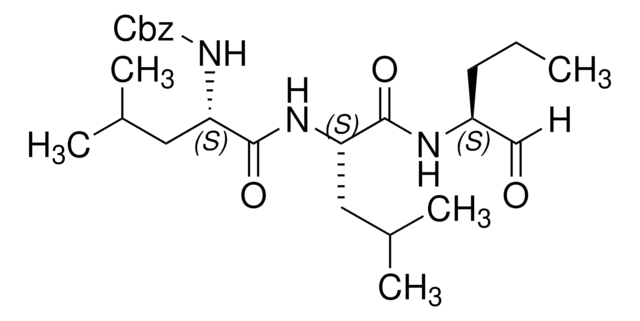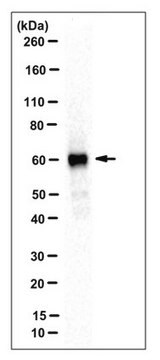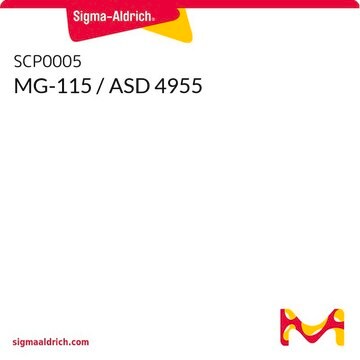M7449
MG-132, Ready Made Solution
≥90% (HPLC)
Synonym(s):
MG-132 Proteasome Inhibitor
Sign Into View Organizational & Contract Pricing
All Photos(1)
About This Item
Recommended Products
Quality Level
Assay
≥90% (HPLC)
form
DMSO solution
quality
useful for proteasome inhibition
concentration
10 mM in DMSO
shipped in
dry ice
storage temp.
−20°C
Amino Acid Sequence
Z-Leu-Leu-Leu-al
General description
MG132 is a potent proteasome inhibitor that also inhibits calpains and lysosomal cathepsins. One of the first proteasome inhibitors to be developed, MG-132 is widely used in proteasome inhibition studies because of its high potency, high selectivity, and rapid reversibility. MG132 mechanistically acts as a proteasome inhibitor by hemiacetal formation with hydroxyl groups of active site threnonine residues.
Application
MG-132, Ready Made Solution has been used to inhibit the proteasome in various systems, including:
- hTERT-RPE1 and HeLa cells: Osorio-Zambrano, W.F. et al., PLoS One, 10(12), e0144434 (2015)
- FaDu human hypopharynx cancer cells: Kim, S.-Y. et al., Autophagy, 14(3), 385-403 (2018)
- HEK293 cells: Chen, Q. et al., Cell Reports, 22(11), 2860-2872 (2018).
- Neonate rat cardiomyocytes: Turkieh, A. et al., Cell Death Dis., 10(8), 608 (2019)
- Adult neural stem cells: Morrow, C.S. et al., Cell Stem Cell, 26(4), 558-568.e9 (2020).
Biochem/physiol Actions
MG132, also known as carbobenzoxy-Leu-Leu-leucinal, is a peptide aldehyde which plays a vital role in the inhibition of proteolytic activity of the 26S proteasome complex. MG132 retards the growth of HeLa cells by promoting cell cycle arrest and apoptosis. Treatment of HepG2 and HeLa cells with MG-132 triggers increased expression of MCPIP1 mRNA, which in turn increases MCPIP1 protein concentration. MCPIP1 is implicated in negative regulation of macrophage activation and differentiation of several cell types, including pre-adipocytes, neuroprogenitor cells and osteoclast precursors. MG-132 stimulates dopamine reduction and nigral dopaminergic degeneration in both cell culture and animal models of Parkinson′s disease.
Potent, membrane-permeable proteasome inhibitor. Induces neurite outgrowth in PC12 cells at 10 μM. Blocks cleavage of poly(ADP-ribose) polymerase and apoptosis in thymocytes. Proteasome inhibition induces accumulation of heat shock protein mRNA, activation of heat-shock proteins, and enhanced thermotolerance in various cell types: however, it also activates JNK-1, which initiates apoptosis in response to cell stress.
Features and Benefits
- Ready-to-use solution in DMSO
- Purity tested by HPLC
Physical form
MG-132, Ready Made Solution is supplied as a 10 mM (1 mg/210 μL) 0.2 μm-filtered solution in DMSO.
Storage Class Code
10 - Combustible liquids
WGK
WGK 2
Flash Point(F)
188.6 °F - closed cup
Flash Point(C)
87 °C - closed cup
Certificates of Analysis (COA)
Search for Certificates of Analysis (COA) by entering the products Lot/Batch Number. Lot and Batch Numbers can be found on a product’s label following the words ‘Lot’ or ‘Batch’.
Already Own This Product?
Find documentation for the products that you have recently purchased in the Document Library.
Customers Also Viewed
Loss-of-function mutations in the ATP13A2/PARK9 gene cause complicated hereditary spastic paraplegia (SPG78).
Estrada-Cuzcano A
Brain, 140(Pt 2), 287-305 (2017)
Proteasome inhibitor MG-132 induces dopaminergic degeneration in cell culture and animal models.
Sun F
Neurotoxicology, 27(5), 807-815 (2006)
Proteasome inhibitor MG-132 induces MCPIP1 expression.
Skalniak L
FEBS Journal, 280(11), 2665-2674 (2013)
RhoA Activation Sensitizes Cells to Proteotoxic Stimuli by Abrogating the HSF1-Dependent Heat Shock Response.
Meijering RA
PLoS ONE, 10(7), e0133553-e0133553 (2015)
Héctor Gálvez et al.
Frontiers in molecular neuroscience, 10, 321-321 (2017-11-07)
Atonal homolog 1 (Atoh1) and Neurogenin1 (Neurog1) are basic Helix-Loop-Helix (bHLH) transcription factors crucial for the generation of hair cells (HCs) and neurons in the inner ear. Both genes are induced early in development, but the expression of Atoh1 is
Our team of scientists has experience in all areas of research including Life Science, Material Science, Chemical Synthesis, Chromatography, Analytical and many others.
Contact Technical Service







